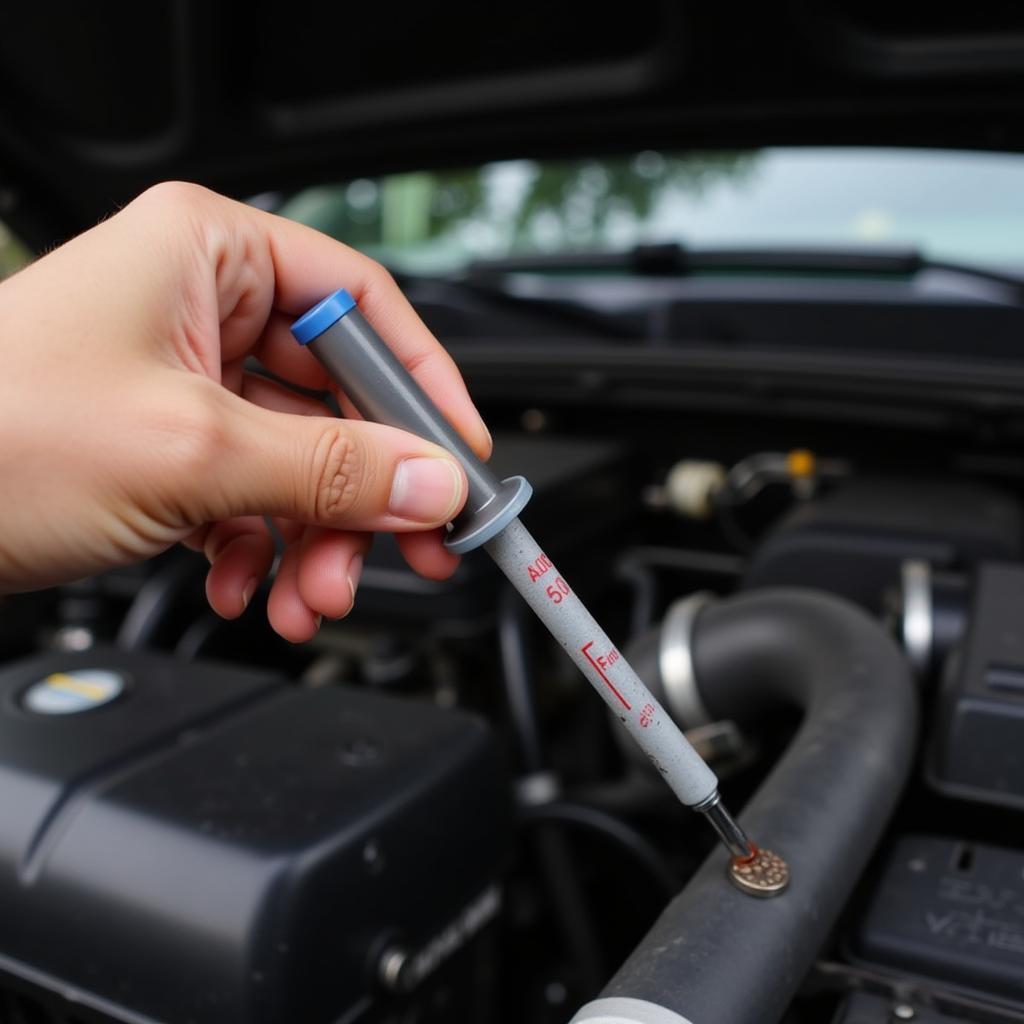Maintaining proper tire pressure is crucial for safe and efficient driving. Not only does it affect your car’s handling and fuel economy, but it also plays a significant role in tire longevity. If you’ve noticed your car pulling to one side, your ride feeling bumpier than usual, or your TPMS (Tire Pressure Monitoring System) light flashing, it might be time to check and adjust your tire pressure. Don’t worry, fixing the air pressure in your car is a straightforward process that anyone can handle. Let’s dive into the steps.
Understanding Tire Pressure
Before we jump into the “how-to,” it’s essential to grasp the basics of tire pressure. Measured in pounds per square inch (PSI), tire pressure refers to the amount of air compressed within your tire.
Finding the recommended PSI for your vehicle is simple. Check the sticker located on your driver’s side door jamb, glove box, or your owner’s manual.
 Checking tire pressure sticker on car door jamb
Checking tire pressure sticker on car door jamb
Important Note: Don’t rely solely on the PSI printed on the tire’s sidewall. That number indicates the tire’s maximum pressure capacity, not necessarily your vehicle’s recommended PSI.
Gathering the Necessary Tools
To fix the air pressure in your car, you’ll need a few basic tools:
- Tire pressure gauge: This tool is vital for accurate PSI readings. You can find digital or analog gauges at most auto parts stores.
- Air compressor: Available at gas stations, car washes, or for purchase at auto parts stores, an air compressor allows you to inflate your tires to the correct PSI.
- Valve stem cap: These small caps are essential for preventing air leakage from the valve stem. Ensure each tire has one securely fastened.
Steps to Fix Air Pressure in Your Car
1. Check Your Tire Pressure
Using your tire pressure gauge, measure the PSI of each tire. Make sure the tires are “cold” – meaning they haven’t been driven on for at least three hours.
2. Compare with Recommended PSI
Compare your readings with the recommended PSI found on your vehicle’s sticker or owner’s manual.
3. Inflate or Deflate Tires
- If the PSI is too low: Use the air compressor to inflate the tires to the recommended PSI. Check the pressure regularly as you inflate to avoid overinflation.
- If the PSI is too high: Press the metal pin in the center of the tire valve stem to release air. Recheck the pressure frequently and stop releasing air once you reach the recommended PSI.
4. Replace Valve Stem Caps
After inflating or deflating your tires, ensure each valve stem cap is tightly secured to prevent air leaks.
Additional Tips for Maintaining Proper Tire Pressure
- Regularly check your tire pressure: Aim to check your tire pressure at least once a month, and before any long road trips.
- Consider temperature fluctuations: Tire pressure can fluctuate depending on the ambient temperature. Remember that for every 10-degree drop in temperature, your tire pressure can decrease by about 1-2 PSI.
- Don’t forget the spare tire: Just like your other tires, your spare tire needs to be properly inflated in case of an emergency.
When to Seek Professional Help
While adjusting your tire pressure is a relatively simple task, there are times when seeking professional assistance is advisable. If you experience any of the following, consider taking your car to a trusted mechanic:
- Persistent air leaks: If you find yourself frequently needing to add air to your tires, you may have a slow leak that needs professional attention.
- TPMS light remains illuminated: If your TPMS light stays on even after adjusting your tire pressure, it could indicate a problem with the system itself.
Maintaining proper tire pressure is fundamental to automotive safety and performance. By following these steps, you can ensure your tires are always properly inflated, enhancing your safety, improving your car’s fuel efficiency, and extending the lifespan of your tires.
If you require assistance with your car’s AC system or any other automotive issue, don’t hesitate to contact the experts at AutoTipPro. You can reach us at +1 (641) 206-8880 or visit our office at 500 N St Mary’s St, San Antonio, TX 78205, United States.
FAQs
1. Can I overinflate my tires?
Yes, it’s possible to overinflate your tires. Overinflating can lead to a harsher ride, reduced tire lifespan, and increased risk of blowouts. Always refer to your vehicle’s recommended PSI.
2. What if my tire pressure is different on each side?
Slight variations in tire pressure between the left and right sides are normal. However, significant differences could indicate an issue with your alignment or suspension.
3. How often should I rotate my tires?
Tire rotation is crucial for even tire wear. It’s generally recommended to rotate your tires every 5,000 to 8,000 miles. Consult your owner’s manual for specific recommendations for your vehicle.
4. Does tire type affect pressure?
Yes, different tire types (e.g., summer tires, winter tires) may have different pressure recommendations. Always refer to the tire manufacturer’s guidelines.
5. What if my tire pressure light blinks?
A blinking TPMS light usually indicates a system malfunction. Have your TPMS inspected by a qualified mechanic.






Leave a Reply